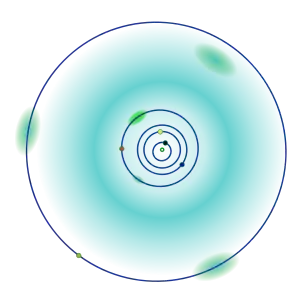2016 CP31
2016 CP31 is a small asteroid and Mars trojan orbiting near the L5 point of Mars (60 degrees behind Mars on its orbit).[2][3][4]
| Discovery | |
|---|---|
| Discovered by | Catalina Sky Survey |
| Discovery date | 7 February 2016 |
| Designations | |
| 2016 CP31 | |
Martian L5  | |
| Orbital characteristics[1] | |
| Epoch 31 May 2020 (JD 2459000.5) | |
| Uncertainty parameter 0 | |
| Observation arc | 1652 days (4.52 yr) |
| Aphelion | 1.61311791 AU (241.319005 Gm) |
| Perihelion | 1.4341118 AU (214.54007 Gm) |
| 1.52361487 AU (227.929540 Gm) | |
| Eccentricity | 0.0587439 |
| 1.88 yr (686.92802 d) | |
| 122.0549° | |
| 0° 31m 26.661s /day | |
| Inclination | 23.130505° |
| 154.488290° | |
| 329.2083° | |
| Earth MOID | 0.455015 AU (68.0693 Gm) |
| Jupiter MOID | 3.39497 AU (507.880 Gm) |
| Physical characteristics | |
Mean diameter | 400 m |
| 0.5-0.05 (assumed) | |
| 19.5 | |
Discovery, orbit and physical properties
2016 CP31 was first observed on 7 February 2016 by the Catalina Sky Survey; the Pan-STARRS 1 telescope system at Haleakala had imaged this object on 14 January 2016 without identifying it as an asteroid.[5] Its orbit is characterized by low eccentricity (0.059), moderate inclination (23.1°) and a semi-major axis of 1.52 AU.[5] Upon discovery, it was classified as Mars-crosser by the Minor Planet Center. Its orbit is well determined as it is currently (January 2021) based on 131 observations with a data-arc span of 1652 days.[1] 2016 CP31 has an absolute magnitude of 19.5 which gives a characteristic diameter of 400 m.[1]
Mars trojan and orbital evolution
Recent calculations indicate that it is a stable L5 Mars trojan.[2] It may not be a member of the so-called Eureka family.
See also
References
- "JPL Small-Body Database Browser: (2016 CP31)". Jet Propulsion Laboratory. Retrieved 12 January 2021.
- Christou, Apostolos A.; Borisov, Galin; Dell'Oro, Aldo; Jacobson, Seth A.; Cellino, Alberto; Unda-Sanzana, Eduardo (January 2020). "Population control of Mars Trojans by the Yarkovsky & YORP effects". Icarus. 335 (1): 113370 (34 pages). arXiv:1907.12858. Bibcode:2020Icar..33513370C. doi:10.1016/j.icarus.2019.07.004. S2CID 198985887.
- Christou, Apostolos A.; Borisov, Galin; Dell'Oro, Aldo; Cellino, Alberto; Devogèle, Maxime (January 2021). "Composition and origin of L5 Trojan asteroids of Mars: Insights from spectroscopy". Icarus. 354 (1): 113994 (22 pages). arXiv:2010.10947. Bibcode:2021Icar..35413994C. doi:10.1016/j.icarus.2020.113994. S2CID 224814529.
- de la Fuente Marcos, Carlos; de la Fuente Marcos, Raúl (March 2021). "Using Mars co-orbitals to estimate the importance of rotation-induced YORP break-up events in Earth co-orbital space". Monthly Notices of the Royal Astronomical Society. 501 (4): 6007–6025. arXiv:2101.02563. Bibcode:2021MNRAS.501.6007D. doi:10.1093/mnras/stab062.
- MPC data on 2016 CP31
Further reading
- Three new stable L5 Mars Trojans de la Fuente Marcos, C., de la Fuente Marcos, R. 2013, Monthly Notices of the Royal Astronomical Society: Letters, Vol. 432, Issue 1, pp. 31–35.
- Orbital clustering of Martian Trojans: An asteroid family in the inner solar system? Christou, A. A. 2013, Icarus, Vol. 224, Issue 1, pp. 144–153.
External links
- 2016 CP31 data at MPC.
- 2016 CP31 at AstDyS-2, Asteroids—Dynamic Site
- 2016 CP31 at the JPL Small-Body Database

